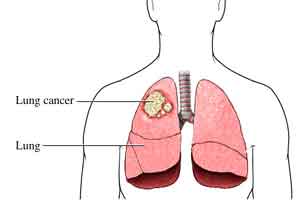- Home
- Editorial
- News
- Practice Guidelines
- Anesthesiology Guidelines
- Cancer Guidelines
- Cardiac Sciences Guidelines
- Critical Care Guidelines
- Dentistry Guidelines
- Dermatology Guidelines
- Diabetes and Endo Guidelines
- Diagnostics Guidelines
- ENT Guidelines
- Featured Practice Guidelines
- Gastroenterology Guidelines
- Geriatrics Guidelines
- Medicine Guidelines
- Nephrology Guidelines
- Neurosciences Guidelines
- Obs and Gynae Guidelines
- Ophthalmology Guidelines
- Orthopaedics Guidelines
- Paediatrics Guidelines
- Psychiatry Guidelines
- Pulmonology Guidelines
- Radiology Guidelines
- Surgery Guidelines
- Urology Guidelines
Foods with high glycemic index push up lung cancer risk- Study

New York: Consuming foods and beverages with a high glycemic index, such as white bread or bagels, corn flakes and puffed rice, is linked with an increased risk of developing lung cancer, says a study.
Glycemic index (GI) is a measure of the quality of dietary carbohydrates, defined by how quickly blood sugar levels are raised following a meal.
The link between GI and lung cancer is particularly prominent in particular subgroups, such as never-smokers and those diagnosed with the squamous cell carcinoma (SCC) subtype of lung cancer, showed the study published in the journal Cancer Epidemiology, Biomarkers & Prevention.
The researchers surveyed 1,905 patients newly diagnosed with lung cancer and 2,413 healthy individuals.
Participants self-reported past dietary habits and health histories.
"We observed a 49 percent increased risk of lung cancer among subjects with the highest daily GI compared to those with the lowest daily GI," said senior author of the study Xifeng Wu, professor at The University of Texas MD Anderson Cancer Centre in the US.
"The associations were more pronounced among subjects who were never smokers, diagnosed with squamous cell carcinoma or had less than 12 years of education," Wu noted.
Interestingly, the researchers found that glycemic load (GL), a measure of carbohydrate quantity, had no significant associations with lung cancer risk.
"This suggests that it is the average quality, instead of quantity, of carbohydrates consumed that may modulate lung cancer risk," Wu said.
When investigating never-smokers in the study, the researchers found that those in the highest GI group were more than twice as likely to develop lung cancer as those in the lowest group.
Among smokers, the risk was only elevated by 31 percent between the two groups.
While tobacco use is the leading cause of lung cancer, it fails to account for all cases, particularly in those who never smoked.
Accumulating evidence suggests that dietary factors may modulate lung cancer risk, Wu, noted.
While specific dietary recommendations cannot be made on the basis of these results, the authors suggested limiting foods and beverages with high GI.
Examples of low GI foods include whole-wheat or pumpernickel bread, rolled or steel-cut oatmeal and pasta.
Glycemic index (GI) is a measure of the quality of dietary carbohydrates, defined by how quickly blood sugar levels are raised following a meal.
The link between GI and lung cancer is particularly prominent in particular subgroups, such as never-smokers and those diagnosed with the squamous cell carcinoma (SCC) subtype of lung cancer, showed the study published in the journal Cancer Epidemiology, Biomarkers & Prevention.
The researchers surveyed 1,905 patients newly diagnosed with lung cancer and 2,413 healthy individuals.
Participants self-reported past dietary habits and health histories.
"We observed a 49 percent increased risk of lung cancer among subjects with the highest daily GI compared to those with the lowest daily GI," said senior author of the study Xifeng Wu, professor at The University of Texas MD Anderson Cancer Centre in the US.
"The associations were more pronounced among subjects who were never smokers, diagnosed with squamous cell carcinoma or had less than 12 years of education," Wu noted.
Interestingly, the researchers found that glycemic load (GL), a measure of carbohydrate quantity, had no significant associations with lung cancer risk.
"This suggests that it is the average quality, instead of quantity, of carbohydrates consumed that may modulate lung cancer risk," Wu said.
When investigating never-smokers in the study, the researchers found that those in the highest GI group were more than twice as likely to develop lung cancer as those in the lowest group.
Among smokers, the risk was only elevated by 31 percent between the two groups.
While tobacco use is the leading cause of lung cancer, it fails to account for all cases, particularly in those who never smoked.
Accumulating evidence suggests that dietary factors may modulate lung cancer risk, Wu, noted.
While specific dietary recommendations cannot be made on the basis of these results, the authors suggested limiting foods and beverages with high GI.
Examples of low GI foods include whole-wheat or pumpernickel bread, rolled or steel-cut oatmeal and pasta.
BiomarkerscancerCancer EpidemiologyGlycemic index (GI)glycemic load (GL)Lung CancerSCCsquamous cell carcinomaThe University of Texas MD Anderson Cancer CentreXifeng Wu
Source : IANSNext Story
NO DATA FOUND

Disclaimer: This site is primarily intended for healthcare professionals. Any content/information on this website does not replace the advice of medical and/or health professionals and should not be construed as medical/diagnostic advice/endorsement or prescription. Use of this site is subject to our terms of use, privacy policy, advertisement policy. © 2020 Minerva Medical Treatment Pvt Ltd